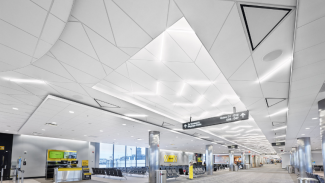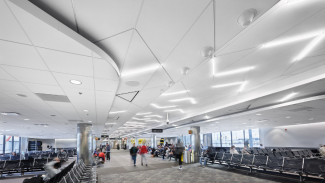Unique new ceiling imparts dynamic sense of movement at BWI Airport
Airport management desired a system that would stand out and create the illusion of a higher ceiling. JMT Architecture worked with AIA partner Armstrong to devise a solution.

Baltimore/Washington International (BWI) Thurgood Marshall Airport in Baltimore recently underwent a substantial upgrade to the HVAC system in its Concourse D. As part of the project, a decades-old ceiling was removed. According to Design Associate Jennifer Hensel of JMT Architecture in Hunt Valley, Maryland, “Airport management desired a new ceiling and lighting system in the central corridors that would help create the illusion of higher ceilings and really stand out. They wanted it to be unique and dynamic while imparting a sense of movement.”
To meet the design objective, Hensel chose Calla Shapes for DesignFlex, an Armstrong ceiling system that provides the opportunity to mix and match different shapes, sizes, colors, and materials to create a signature ceiling. Three different panel shapes were used in the corridor ceiling – 45o left parallelograms, 45o right parallelograms, and 45o triangles.

T-Bar light fixtures replace grid
In addition, many of the cross members in the suspended ceiling grid system were replaced with JLC Tech T-Bar Flex lights specifically designed to integrate with the Armstrong ceilings. “We were looking to create a sense of movement throughout the central corridor similar to birds in flight,” Hensel noted. Triangular Price air diffusers, also designed to integrate with Armstrong ceilings, were installed in a tier of panels below the main corridor ceiling.
ProjectWorks, the complimentary Armstrong design and pre-construction service, assisted in the project. “Once we had our design, ProjectWorks provided a comprehensive drawing package,” Hensel stated. “This helped simplify installation since different colors represented different panels and the layouts displayed how the different panel shapes are installed throughout the space.”

Restricted work hours
When it came to installation, project manager Karl Owens of Northern Contracting Co. in Bel Air, Maryland, reported his crews had never installed a DesignFlex ceiling before. “However, the panel, grid, and hub layouts provided by ProjectWorks were a big help and everything went well,” he said.
“The real challenge was the concourse was fully operational during the project, so we could only work at night when far fewer passengers were around,” he noted. In addition, the crews could only open up 2,500 square feet at a time because of fire codes. “We needed enough material to cover a section each night,” Owens said. “But there was no place to store materials, so staging was a logistical nightmare and required a lot of coordination.”
The sheer size of the project also created challenges with alignment throughout the long, straight corridor. “We couldn’t use a laser when passengers were present,” the contractor noted, “so we often had to use a string line.”
The corridors totaled more than 26,000 square feet, requiring the installers to accurately locate, position, and install more than 6,000 brackets and field connect to nearly 2,000 perimeter connection clips. The project also required the integration of nearly 850 light fixtures and the installation of nearly 10,000 feet of Armstrong Axiom trim. The variety of trim installed throughout the concourse included both straight and curved trim as well as moldings and column rings.

Same smooth finish above gate areas
In addition to the central corridors, the project also included the installation of 45,000 square feet of 2’ x 2’ Calla ceiling panels above the holding/gate areas. Hensel reported the Calla ceilings were chosen for three reasons: “The first was visual,” she said. “We wanted to match the same smooth finish as the ceiling in the corridor. We did not want a real fissured panel. Second, we wanted more light reflection because the existing ceiling was very dark. Calla panels have a light reflectance value of 0.85. And third, better acoustical performance.” Calla panels feature Armstrong Total Acoustics performance, meaning they both absorb sound (NRC = 0.85) and block sound (CAC = 35) in the same panel.
The result is three overlapping tiers of ceilings that dominate the space with the eye-catching central corridor being the highest tier and the holding/gate areas the lowest.
Learn more about Transportation solutions at www.armstrongceilings.com/transportation.
AIA does not sponsor or endorse any enterprise, whether public or private, operated for profit. Further, no AIA officer, director, committee member, or employee, or any of its component organizations in his or her official capacity, is permitted to approve, sponsor, endorse, or do anything that may be deemed or construed to be an approval, sponsorship, or endorsement of any material of construction or any method or manner of handling, using, distributing, or dealing in any material or product.



